Culture of Papua New Guinea
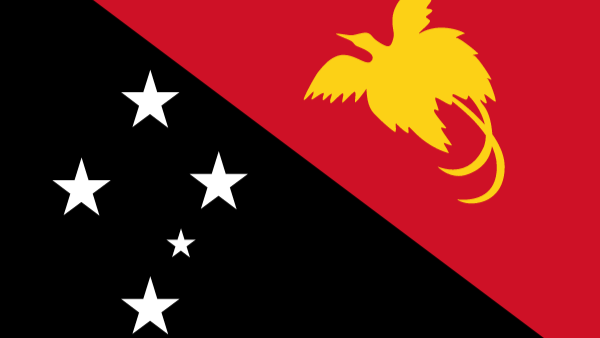
Culture Name
Papua New Guinean
Alternative Names
Niugini (Pidgin English)
Orientation
Identification. Papua is probably derived from the Malay word papuwah ("fuzzy hair"). In 1545, a Spanish explorer called the island Nueva Guinea .In 1884, the western half of New Guinea was officially recognized as Dutch New Guinea, the northeastern section became German New Guinea, and the southeastern quarter became British New Guinea. In 1905, Australia took over the territory, renaming it the Territory of Papua. After World War II, the British and German territories were combined and jointly administered by Australia as the Territory of Papua and New Guinea. In 1975, the country became Papua New Guinea or, officially, the Independent State of Papua New Guinea.
Location and Geography. Papua New Guinea consists of eastern New Guinea along with New Britain, New Ireland, Bougainville, and six hundred small islands and archipelagoes. The land area is over 178,000 square miles (462,000 square kilometer), with the mainland accounting for 80 percent. The western half of the island is the Indonesian province of Irian Jaya. To the south is Australia, and to the east and southeast are the Solomon Islands and other Melanesian countries. To the north and northwest are the Philippines, South Korea, and Japan.
The central mountain chain extends the length of the island and is covered in tropical rain forest. Upland valleys and the headwaters of fast-flowing rivers descend to the coast through some of the world's largest swamps.
Papua New Guinea has a tropical monsoon climate and is generally hot and humid, although the climate varies from one area to another.
Over 75 percent of the nation is covered in rain forest. Swamp forest is found in the poorly drained lowlands, and sago palm is a staple food of the people living there. Around Port Moresby and in drier areas to the west are grassy plains and savanna woodlands.
Demography. The 1990 census showed a population of 3,761,954. Over half the population was under age 20. With an annual growth rate of 2.3 percent, the population topped four million by 1992 and is expected to grow to more than five million by the year 2000. Around 85 percent of the population lives in small villages and rural outposts; the other 15 percent is concentrated in ten major urban areas where most of the non-Melanesian population of about 25,000 resides. The largest cities are Port Moresby with a population over 220,000, Lae (90,000), Madang (30,000), Mt Hagen (45,000), Wewak (23,000), and Goroka (25,000).
Linguistic Affiliation. Well over one thousand languages are spoken throughout New Guinea. After Colonization, Papua New Guineans needed to communicate with one another and with outsiders. On German (and later Australian) plantations and wherever individuals speaking different languages met, a pidgin language referred to as Neo-Melanesian or Melanesian Pidgin developed. Now known as Tok Pisin ("talk pidgin"), Melanesian Pidgin is spoken throughout Papua New Guinea. While English is taught in school and is the official language of business and government, Tok Pisin is a symbol of national identity and a preferred means of communication. Hiri Motu, a trade language that originated on the south coast in Papua among participants in a traditional trade network, is spoken only in that area.
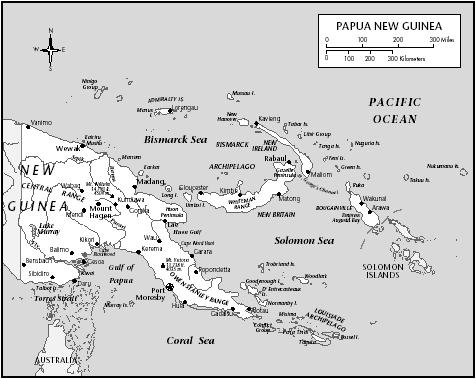
Papua New Guinea
Symbolism. While preparing for independence and attempting to promote national identity, leaders and artists drew on symbols reflecting the nation's unique cultural and natural diversity and continuing traditions. The national flag is a rectangle divided diagonally from the top left corner to the bottom right. The upper triangle is red with a yellow bird of paradise; the lower triangle is black with five white stars representing the Southern Cross. Black, red, and yellow are traditional colors in many Papua New Guinean societies. Items of traditional exchange ( kina shells, pigs) are prominent on the currency. The Southern Cross symbolizes the country's close relations with other South Pacific nations. The national song, "O Arise All You Sons," reflects a commitment to Christianity in its references to God and the "Lord".
History and Ethnic Relations
Emergence of the Nation. Before colonization, an individual's identity was grounded in his or her kin group and rarely extended beyond the kin groups of close relatives and in-laws. While an individual may have shared a language and culture with tens of thousands of persons, only leaders and other unusual individuals spent time outside the villages nearest to his or her "place." After colonization, Papua New Guineans experienced political, social, and economic integration. Missionaries and administrators suppressed "tribal" warfare to allow freedom of movement and integrated villagers into the colonial economy as plantation workers and mission helpers. Missionary activities also led to the spread of Christianity and Western education; the building of roads, airstrips, and radio stations; and the shared experience of racial prejudice directed at local peoples by many whites.
Colonization and change were uneven, with island and coastal areas colonized before the interior and some groups resisting change for decades. Outsiders did not visit the highlands until the 1930s, and some areas were first contacted as late as the 1970s. Differences in education and economic development contributed to ethnic and class differences.
National Identity. In the 1960s, Australia moved toward liberating Papua New Guinea by establishing self-government and a House of Assembly and building institutions of higher learning to train an educated elite to serve the country.
The focus on higher education was matched by efforts to foster closeness and national pride among the students that would cut across ties with wantoks (those in the same language group) and flow outward to the rest of the country. Students were taught to express their experiences in poetry, music, stories, and art that dealt with the "beauty of village life," the opposite sex, pride in their cultures, and the question of how they could lead the country into the modern world without becoming selfish. Regardless of this soul-searching, class differences are emerging as educated parents with good jobs provide for their children's future, and there is increasing intermarriage between persons of different cultural background who mingle in school and at work. Communicating in English or Tok Pisin, many couples fail to pass on their mother tongues to their children, alienating their village kin.
Ethnic Relations. Before independence on 16 September 1975, a number of micronationalist movements threatened secession from a nation that many felt was a colonial invention. Papua Besena emerged in 1973 under the leadership of Josephine Abaijah. Its objective was to free Papua from Australian colonial rule and unification with the more heavily populated New Guinea. In March 1975, Papua Besena declared Papuan independence but did not go beyond that symbolic act.
In 1964, the discovery of copper in Bougainville resulted in the construction of a giant copper mine. It was argued that the profits from the mine would benefit all of Papua New Guinea. Bougainvilleans were suspicious of the motives of the Australians and the expatriate company and resentful of the mainland Papua New Guineans who were brought in to build the mine. In November 1988, a guerilla operation began that became the Bougainville Revolutionary Army (BRA). The conflict continued throughout the 1990s and has been difficult for the police and defense forces that have been pitted against fellow citizens.
Urbanism, Architecture, and the Use of Space
Before European settlement, there were no towns. Thousands of villages and hamlets were connected by narrow paths, customs, and networks of marriage and trade partners. Bush material houses were temporary as people moved with their new gardens and as alliances dissolved and re-formed. Men spent their nights with other men and boys in elaborate men's houses, while their wives and female relatives slept and ate in smaller women's houses. Most villages were home to more than one kin group. With colonization, dispersed settlements were combined into larger villages for easier administration and the provision of education and health care. The first towns grew up around mission and administrative centers, near airstrips, or on hillsides overlooking good harbors. Towns were small, and homes and nonresidential structures were simple one-story buildings. The first Papua New Guineans to live in towns were men. Many workers were chosen from nearby villages to which they were expected to return at night, but some lived in servants' quarters ( boi haus ) or company barracks. The exclusion of New Guineans from areas of European settlement was maintained almost up until independence. After World War II, there was an expansion of economic opportunities for both colonizers and local peoples, resulting in a rapid growth of towns and an increase in urban migration as men, and later their wives and children, came to town seeking employment, education, and excitement. The Australians tried to control the influx by building company housing for workers and their families and denying residency rights to other migrants, but that policy was only partly successful. "Squatter" settlements became stepping-stones for migrants who came to test the waters in town and migrants who wanted to save money to invest in their villages. They have become islands of safety in crime-filled towns as wantoks band together, apart from other groups.
In preparing for independence, colonial and Papua New Guinean officials built institutions such as the National Arts School, where students and other artists and architects used traditional and modern elements in designs for buildings in the capital and elsewhere.
Papua New Guineans continue to be ambivalent about the expense and violence of town life. Markets, parks, and shopping centers draw thousands
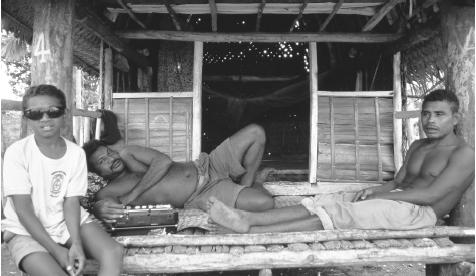
Three men in a bachelor house in Omarakana, Kiriwina, Trobriand Island. Traditionally, even married men lived in separate houses from their wives.
of visitors every day, most of whom are interested in observing the spectacle and meeting up with wantoks to gossip or plan group events. Airports are crowded with travelers' friends and families, onlookers, and unemployed youths observing the movements of people from around the world.
Food and Economy
Food in Daily Life. Staples include starchy vegetables (wild sago, breadfruit, yams, taro, sweet potatoes, and rice) complemented by wild greens, several varieties of bananas, and coconuts, mango, and other fruits. Domestication of animals and hunting provide fowl, pork, and meat from birds, marsupials, turtles, and cassowaries. In riverine and coastal areas, fish and shellfish may form a significant part of the diet. Villagers cook two meals a day, boiling or roasting the food. Earth ovens are dug on ceremonial grounds for special occasions. Leftovers, sugarcane, and coconut milk are consumed while people work in their gardens. Tea is drunk at all times. Urban restaurants provide international cuisine to those who can afford it. Kai bars (fast-food stands) are popular. Food taboos vary and are often temporary, as with restrictions on pregnant women and initiates. Others are totemic, involving plants or animals that are symbolic of kin groups. Still others are relational; for example, a son-in-law may not consume food in the presence of his mother-in-law.
Food Customs at Ceremonial Occasions. Papua New Guinea is renowned for ceremonial occasions at which hundreds of pigs or other valuables are distributed to guests. Competitive feasting ("fighting with food") between big men and chiefs features oratory, dancing, singing, drumming, and feasting that go on for days, along with the payment of bride-prices and other exchanges. Special drinks were rarely part of such ceremonies in the past, but now beer and alcohol are often part of major exchanges. Papua New Guineans celebrate nontraditional holidays such as Christmas and Easter, but rarely with the exuberance or expense involved in a traditional feast.
Basic Economy. Villagers produce most of their own food, and many townspeople plant gardens and rely on open-air markets for fruits and vegetables sold by village women using kina for currency. Urban supermarkets import an array of expensive foods and other items. Most residents rely on small trade stores for rice, sugar, tea, and tinned fish, as well as soap, clothing, blankets, kerosene lanterns, and matches.
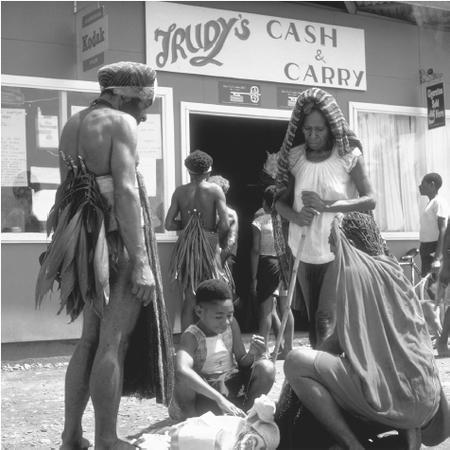
A group of people gather in front of a store in Mount Hagen.
Land Tenure and Property. Most land is vested in kin groups and allocated according to need. Individual land ownership is not common; individuals may own a grove of banana trees but not the land they grow on. While land normally passes from father or mother's brother to children or nieces and nephews, the intended recipients provide much assistance and gifts to the "owners" before the land passes to their care. Migrants who fail to participate in village exchanges risk being "dispossessed" in favor of people who have supported local landowners.
Commercial Activities. Commerce is centered in the towns. Papua New Guinea developed its own television station in the late 1980s, and radio news and entertainment shows reach most villages. Tourism brings forty thousand visitors a year, mostly to the Sepik River and Trobriands. The road system is limited. Port Moresby is cut off from the rest of the country except by air and ship. With most places being difficult to reach, there are many undeveloped areas and labor migration is high.
Major Industries. The major industries are extractive. In addition to gold mining and oil drilling, major industries include coffee, copra, cocoa, cattle, oil palm, timber and wood-chip mills, and tuna canneries.
Trade. Traditional artifacts and carvings are sold throughout the world but provide only a small income. Important exports are copper, gold, coffee, cocoa, copra, coconut oil, and timber. Imports include machinery and transport equipment, food and live animals, manufactured goods, and pharmaceuticals.
Division of Labor. Outside the cities there is little specialization. The village division of labor is by age and gender, with men and women cooperating to feed their families from gardening and other subsistence activities and children and older persons assisting in a variety of ways. Cash crops generally are owned by men, but men and women tend and harvest them. Urban specialization is served by local schools, and few residents are educated abroad.
Social Stratification
Classes and Castes. There are no castes and only recent evidence of the slow emergence of classes. Economic inequality, however, cuts across ethnic and cultural boundaries. The common perception is of a country divided into "elites" and "grassroots," with the grassroots including most villagers and low-income earners in town and the elites being educated, higher-income persons, "coffee millionaires," and other entrepreneurs. Social interaction is intense as elites attend clan affairs and are expected to open their homes to wantoks at any hour.
There is evidence of growing disparities in the lifestyles and opportunities of elites versus grassroots and of the emergence of a middle class. Most villagers are not poor. Daily life is simple with few of the expenses of urban life. Villagers invest their cash income and traditional wealth in the social and political relations that maintain their place in village society. The elites and the middle class, however, must balance the expenses of living in town with investments in larger kin groups. While the demands of wantoks can act as a powerful leveling force, higher-income families are investing in productive businesses and ensuring that their children have the same class privileges they do.
Symbols of Social Stratification. There are many expensive restaurants and night spots in Port Moresby and other big cities, and the highways are jammed with imported cars. While some elites dress down for work and social occasions in clothes bought at secondhand stores or wear the grassroots fashion for women, the laplap and the meri blouse, many buy their clothes from fashionable boutiques and department stores or overseas. Wealthy citizens have invested in properties outside the country in anticipation of retirement or a people's revolution.
Political Life
Government. Papua New Guinea is an independent Commonwealth nation that achieved independence on 16 September 1975 from the Australian-administered United Nations trusteeship. It is a parliamentary democracy with a governor general representing the British Crown, a prime minister and cabinet, and a 109-member unicameral, popularly elected parliament. The legal system is based on English common law. There is a Supreme Court in which the chief justice is appointed by the governor general on the recommendation of the National Executive Council. Other judges are appointed by the Judicial and Legal Services Commission. There is universal suffrage, and the voting age is 18 years. In 1977, the Organic Law on Provincial Government resulted in decentralization. There are nineteen provinces (former colonial districts), each with an elected assembly, premier, and cabinet. There is also a National Capital District. At the local level there are local government councils that lost power as provincial governments gained government resources and funds. Corruption and other difficulties led to the abolition of provincial governments in 1995 and their replacement with a local government structure headed by governors in each province.
Leadership and Political Officials. Most traditional leaders achieved influence by building extensive networks of exchange partners and supporters. The characteristic "big man" was hardworking, skilled in oratory, personable, intelligent, generous, and the husband of more than one wife. Big men still exist, but their influence has lessened because they cannot control the global forces affecting their communities. Candidates for higher office must build multiple local power bases, an expensive and delicate political operation that often results in questionable campaign practices and eventual electoral disappointment and single terms of office. There are many political parties, and prime ministers must forge coalitions. Parties are unstable and hard to distinguish on the basis of substantive issues. Prime ministers rarely stay in office for the
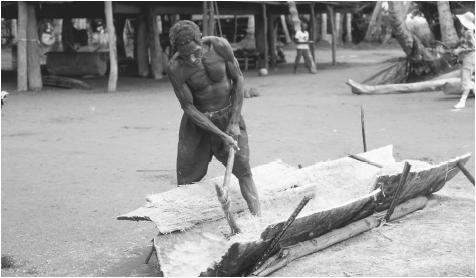
A man splitting a sago palm trunk using traditional tools.
full five years, and parliament members switch parties frequently.
Social Problems and Control. There are both village and national court systems. Village courts use custom rather than English law, a situation that sometimes results in injustice from the point of view of the larger society. A chief ombudsman can resolve some conflicts between the two systems, but his reach rarely extends beyond Port Moresby. Policing a large and thinly populated country is difficult, and many citizens fear the police. Rural police sometimes compensate for inadequate manpower by using excessive force with lawbreakers; and urban police can be equally brutal. Crimes go unreported because citizens fear police brutality or prefer to handle the offenders, who are often kin, themselves. The police have been known to take the law into their own hands, as has the Papua New Guinea Defense Force. The nation's "law and order" problem is multifaceted, but the depredations of youthful gangs, outbreaks of rioting and looting, and the resurgence of tribal warfare are major sources of disorder and misery.
Military Activity. The nation's only major military action has been the ongoing conflict with the Bougainville Revolutionary Army. In the late 1970s and 1980s, there were fears of an Indonesian invasion across the border with Irian Jaya. A small guerilla freedom movement of no more than four hundred men used the sparsely populated border area to stage attacks against the Indonesian army and then flee to the Papua New Guinea side. Unwilling to contemplate war with the much larger Indonesia, Papua New Guinea used its armed forces to send refugees back across the border and capture rebels.
Social Welfare and Change Programs
There is little support for social welfare and change programs. There is no social security system, few institutions to help the mentally ill or handicapped, and no welfare programs or food stamps. Part of the problem is the government's need to spend money on roads, schools, and basic infrastructure for a population thinly spread over a rugged countryside. Another problem is the belief that the extended family or village will always care for its own. Nonetheless, Papua New Guinea has supported offensives against several social problems, including wife beating and the rise in AIDS and other sexually transmitted diseases (STDs).
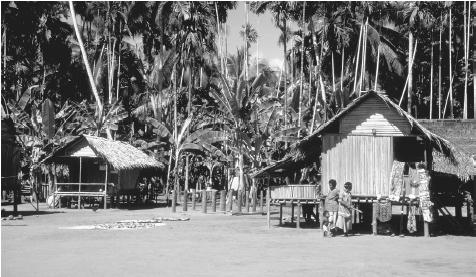
Houses in Eware Village in Morobe.
Nongovernmental Organizations and Other Associations
Nongovernmental organizations and voluntary associations help residents confront rapid social and economic changes. Organizations with multiple aid programs include the Australian International Development Assistance Bureau (AIDAB), the United Nations Development Programme (UNDP), and the International Red Cross. AIDAB's Women in Development Fund targets women as beneficiaries of financial and educational support, teaching business and management training, giving women start-up funds, and encouraging family planning and women's political involvement. The UNDP office in Port Moresby officially opened in 1975.
Voluntary organizations include Canadian University Services Overseas (CUSO), Japan International Cooperation Agency (JICA), the U.S. Peace Corps, and British Voluntary Service Overseas (VSO). Community Aid Abroad (Australia) and Ecological Enterprises support or enhance the work of the Papua New Guinea Integral Human Development Trust, a literacy and awareness resource group with twenty-three member organization that is involved in programs for progressive social change. It has trained over two thousand young men and women as village literacy teachers and runs an AIDS awareness program and the Cross-Cultural Awareness Program for immigrant workers and volunteers.
Gender Roles and Statuses
Division of Labor by Gender. Village subsistence centers on horticulture, with men clearing forests and bush so that their wives can plant gardens and tend pigs. Some crops, such as bananas, sugarcane, and cash crops (such as coffee and cocoa) are planted and tended by men. While women often help pick cash crops, most of the income goes to men. Men build houses and fences, while women make grass skirts and net bags ( bilums ). Women do the daily cooking, while men butcher pigs for feasts. Both men and women look after small children, with a father tending his infant while the mother weeds her gardens. In town, most women do domestic chores and child care while their husbands are at work. Women with jobs employ extended kin to do chores. In both towns and villages, men who do women's work are stigmatized as "rubbish men." Working women do not experience the same stigma, although they suffer prejudice and sexual harassment if they appear too independent and assertive.
The Relative Status of Women and Men. Trobriand chiefs and others who go on open seas
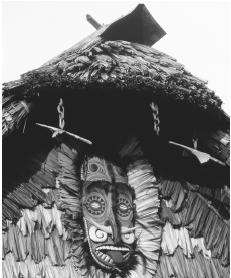
A decorative wood carving on a village hut in Kaminabit Village, near the Sepik River.
Kula (exchange) expeditions and give away yam harvests at the annual yam festival gain authority and privilege, and a chief may have many wives and expect commoners to bow in his presence. However, without female relatives to participate in female exchange events and redeem matrilineage lands and honor, those men's power would evaporate. Among the Gende and many other societies, big men achieve their positions by investing in feasts, bride-prices, and other exchange needs of their partners and followers. To do this, big men need many wives and female helpers to raise food and pigs to give away. Hardworking women are a man's most valuable asset, and husbands who do not consider their wives' interests risk losing them to other men. Women's procreative power induces men to go to great lengths in initiation and other rituals to strengthen themselves for contact with women and achieve a balance or edge in gender relations. In the towns, men and women are redefining their relations. With less education and fewer job opportunities, women do not contribute much income to urban households and as a consequence suffer the infidelities and physical abuses of men who feel burdened by the demands of family and the high expectations extended kin place on employed men, especially those who earn high salaries. Village women help pay back their own bride-prices and assist men in raising cash crops. Some rural women earn money by selling vegetables in urban markets.
Marriage, Family, and Kinship
Marriage. The choice of a marriage partner is rarely left to the individual. After initiation into adult society, young men and women spend time with the opposite sex in supervised courtship sessions. Ideal marriage partners are hardworking and attractive. Clan exogamy is a must, and parents hope their daughters will marry prosperous suitors whose kin pay large bride-prices and who will be good allies in exchange and war. Women pressed into incompatible marriages can return home or threaten suicide. If those strategies fail, young women may run away with lovers or commit suicide.
Men are more likely to be unmarried, as polygyny is practiced and big men attract a greater share of wives. In Gende society, as many as 10 percent of adult males are polygynous at some time. Divorce occurs even in areas where Catholicism is practiced. Often it is the women who initiate it, as men are loath to lose a female worker. After divorce, most adults remarry unless they are very old and living with children or grandchildren.
As Papua New Guineans become more involved in the cash economy and urbanization, marriage patterns are being transformed. Bride-price inflation is one response to economic inequality. The practice of women competing for men rather than men trying to attract women is having an impact on marital politics throughout the nation. Women are in an insecure position, especially urban women who must tolerate domestic abuse and infidelity to hold on to their husbands.
Domestic Unit. The basic village household consists of a husband, a wife, their unmarried children, and perhaps the husband's parents. Extended families live in adjacent houses, gathering frequently for meals, companionship, work parties, and ceremonies. Men's houses are no longer common, although young men may live with other bachelors. Household decisions involve consensus between able-bodied adults, although young wives defer to older members. Residence is usually patrilocal. Less common is matrilocality and avunculocality. Neolocality occurs only in towns. Even then, a couple may be joined by their parents and other kin.
Inheritance. Land and property rights generally pass from parents to children or from uncles to
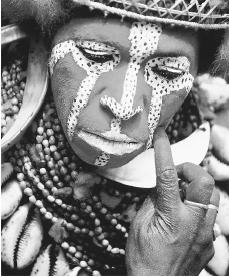
Wife of Papua New Guinea chief applies face paint. Marriages are usually arranged, but women in poor marriages may return home or commit suicide.
nieces and nephews. These kin relations are extended to other members in an individual's kin group. All these persons have an interest in the prosperity of the kin group, and those of the younger generation who contribute the most to that prosperity are likely to receive the most. Reciprocity is a key element, and nonkin can become "sons" and "daughters" of a group if they contribute generously to group affairs. While women generally do not use clan or lineage lands, they retain the option to do so by contributing to group exchanges.
Kin Groups. The important kin groups are patrilineal and matrilineal lineages and clans, Clan members do not necessarily live on clan land. Women marry out, and migrants move far from their ancestral territories to find wage employment and other benefits in town. All the members of a kin group, however, must participate in clan affairs, contributing to bride-prices and other exchanges and helping with initiation and mortuary ceremonies. Clans and lineages can shrink and disappear through deaths and indifference. Persons join other clans, allying themselves with their wives' clans or being adopted as children. An important asset is the land a clan's members hold in common. Land is valuable and a way of life for 85 percent of the population. It is also a form of social security for persons living in towns, most of whom actively engage in kin group affairs to maintain their rural option.
Socialization
Infant Care. Most babies are born outside the village in a birth hut or garden house, where mother and child spend the first few days or weeks after the birth in relative isolation, gathering strength and hiding from malevolent forces. For the next several years, mothers nurse their babies, and the babies are carried everywhere and played with by adoring relatives. In many societies, there is a small feast when the baby, especially a first child, is around a year old to celebrate its existence and let the parents show their appreciation to all those who made its birth possible, including the mother's family and the bride-price supporters.
Child Rearing and Education. Child rearing is indulgent until age five or six for girls and a few years older for boys. Children explore their environment and run free most of the day. Corporal punishment is rare as people believe a child's spirit may leave its body if the child is hit or frightened. A troublesome child is left alone or ignored. If necessary, such children may be taken to the bush or a garden house to act out or sulk. Children are taught by example. Little girls follow in their mothers' and older sisters' footsteps, at first doing child minding or running errands, and later helping in the gardens. Boys spend a longer time playing with other boys but eventually collect firewood and carry water and, later, clear bush and hunt or fish with their fathers. Older boys and girls may go through separate initiation or puberty ceremonies to prepare them for marriage and adulthood. Rituals and taboos are elaborate, arduous, and sometimes terrifying. Young men and women are taught the meanings and responsibilities of their genders to prepare them for social responsibilities and marriage, including sexuality. Badness in children is not something parents blame themselves for; evil spirits may cause a child to be selfish and cruel, in which case, the parents hire a medium.
Higher Education. Higher education is a goal of many parents, especially for their sons. Many parents worry about the physical dangers urban life holds for women. The urban job market is competitive, and some parents are not impressed with the value of a high school or college education, knowing that education does not guarantee a job. Many school leavers and unemployed graduates cause trouble in towns and villages. Parents spend their education dollars on only the brightest, most socially responsible children.
Etiquette
In village society, etiquette centers on reciprocity and being hospitable to guests and unexpected visitors, Feasting exchange partners has an urban equivalent in parties where workmates and wantoks are welcome along with their spouses and children. Reciprocity is expected but is not always possible, putting barriers between individuals of different income levels. One custom that everyone can participate in is sharing betel nut ( buai ). Relations between older and younger and male and female are relaxed. On meeting, men and women of different ages clasp hands or clasp one another around the waist. Couples do not openly express affection in public, but friends of the same sex may hold hands while walking. It is not rude to stare or for persons to crowd one another at counters or stand very close. In chiefly societies, commoners must bow before chiefs and are prohibited from eating foods reserved for the chief and his family.
Religion
Religious Beliefs. The first mission in eastern New Guinea was the London Missionary Society, which in 1871 set up mission teachers from the Loyalty Islands on islands adjacent to and on the Papuan mainland. Some New Guineans resisted the changes missionaries represented, while others accepted opportunities for new forms of wealth, power, and age and gender relations. Working for the mission sometimes provided young men with an income that allowed them to support and choose brides. Schooled in Christian ethics, young women often refused to have bride-prices paid for them. More often, Papua New Guineans have sought to blend old and new religions. Cargo cults aimed at acquiring the wealth and power of outsiders through blends of Christian and local rituals have been common. Today, indigenized forms of Christianity seek to control the human condition in a period of insistent and significant change.
Most societies have stories telling how superhuman beings created the natural world and society, inventing food plants, pigs and pig exchanges, male and female cults, sorcery, and other aspects of culture. In some societies, such deities are important in
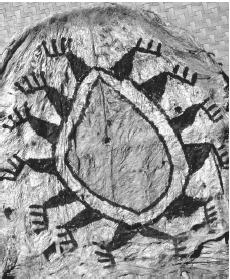
Tapa cloth stretched onto a cane framework is decorated by a painting of an insect.
male and female cults; in others, they have little to do with present fortunes. Instead, sorcerers and witches, the spirits of deceased ancestors, nonhuman forest spirits, and monsters command the attention of the living. Another common belief is that the physical and nonphysical worlds are intertwined and that the well-being of living humans is directly related to the maintenance of proper social ties, adherence to taboos, and the propitiation of spirits. Except in the case of infants and the very old, death is not natural but results from wrongdoing or oversights on the part of the living.
Religious Practitioners. The pragmatic focus of their religions and the absence of a hierarchy is reflected in the intense involvement of Papua New Guineans in the ritual maintenance of their own spiritual and physical well-being. Only in a few chiefly societies do hereditary chiefs and their henchmen act as religious specialists. More generally, it is expected that all adults will acquire magic spells used in gardening, healing or preventing minor illnesses, and love magic. Many people possess a knowledge of sorcery or witchcraft. Big men often purport to be powerful spirit mediums and to possess both healing powers and deadly war sorcery. Witches are deviant or marginalized individuals who are suspected of using their relations with spirits and other cosmic forces to harm members of their own groups.
Rituals and Holy Places. Many rituals focus on health and fertility, such as male and female initiation rituals. Aimed at bringing about the maturation and future success of the initiates, initiation involves seclusion in the forest or a menstrual hut, fasting and food taboos, and body mutilation. Initiates seek contact with spirit guides who will help them throughout their lives and even marry spirit women on occasion. Initiation and other ceremonies focus on eliciting the help of ancestors and the living and are accompanied by the exchange of valuables and food. In preparation for war or in compensation for war deaths, a group may sacrifice hundreds of pigs to call forth the aid of the ancestors. Cannibalism and head-hunting—not universally practiced—were often aimed at rejuvenation or acquiring the bravery and good characteristics of the deceased, with wives eating a portion of their husbands' dead bodies to incorporate their virility and young warriors displaying enemies' heads as symbols of their own magic and efficacy.
Death and the Afterlife. When a person is near death or has died suddenly, mediums are called in to discover the causes and the identity of the sorcerer or witch who may have been involved. Appropriate rituals and sacrifices are performed to prevent death or free the deceased's spirit. Once death has occurred, relatives gather to express their sorrow, wailing and sometimes chopping off fingers, pulling teeth, shaving hair, or pulling out facial hairs. Burial is now common. In the past a corpse might be cremated, thrown in a river or buried at sea, or left in a tree to rot. The dry bones might be buried under a house floor to provide protection to the living with the jawbone worn around the neck of a relative or leader. Rituals believed to help the deceased accommodate to their new state occur at the funeral and at later mortuary ceremonies. Spirits may be encouraged to stay near the living. Some are sent off to a "place of spirits" not far from the living, on mountaintops or in the forest. Funerals and mortuary ceremonies are times to pay off the deceased's debts, recognize his or her accomplishments, and restore friendly relations among the living by exchanging wealth.
Medicine and Health Care
Along with plant medicines and traditional therapies for treating physical symptoms, patients and caregivers use rituals designed to overcome or ascertain the causes of sickness and mental illness, such as ruptured social relations, sorcerers, and ghost attacks. People make use of both Western and traditional treatments in dealing with symptoms while turning to traditional medicine to cure the underlying social and cultural causes of illness. Urban areas have adequate medical staffing in hospitals and clinics. Rural areas are serviced by a thinly spread system of aid posts and small health centers. Aid post workers have only the barest knowledge of first aid. Some village women are trained in midwifery and community-based family-planning services. Trained nurses and paramedics are rare, and doctors even more so. In 1992, there was one doctor for every six thousand persons. In rural areas, health care focuses on first aid and treating chronic diseases such as malaria and pneumonia. Attempts are made to deal with the special health concerns of women and children, including family planning, pregnancy and childbirth, and nutrition and growth. Infant and child mortality rates have dropped, with the most recent figures showing sixty-seven of every one thousand infants dying before the age of twelve months, but women's nutritional needs are not as well met. In many areas, women and girls are fed significantly less than men and boys, resulting in weight loss, anemia, osteoporosis, and greater susceptibility to illness. AIDS, gonorrhea, and syphilis are spreading. Urban use of alcohol, tobacco, sugar, and fatty foods has resulted in increased rates of disease. Medical, sports, and nutrition services and exercise classes are springing up in towns.
Secular Celebrations
There are many local and provincial celebrations, including New Year's Day (1 January), Easter, the Port Moresby Show in mid-June, Remembrance Day (23 July) to commemorate World War II, the Highlands Show in August or September, Independence Day (16 September), and Christmas.
The Arts and Humanities
Support for the Arts. In 1972, the government established the Creative Arts Centre (CAC) to train and support individuals, stage exhibitions, and commission work for national and private projects. In 1976, the CAC became the National Arts School. After Independence, the government supported the arts to promote a national culture. The completion of the parliament building in 1984 marked the apex of national artistic culture.
Literature. After the 1960s, historians and others took a greater interest in oral history and folklore. Oral traditions relating to clan genealogies, initiation and mortuary chants, magic and sorcery, and the teaching of children about their cultures were collected and analyzed, and some were published. In the 1960s and 1970s, there was also an interest in modern Papua New Guinea writing in English. Publishing outlets include the journals Bikmaus , Ondobondo , and The PNG Writer . Autobiographies have been published by overseas companies and by the National Research Institute.
Graphic Arts. The National Arts School offers courses in graphic design, textile design, fine arts, and music. Students are encouraged to generate contacts and income for themselves and the school. In addition to helping with large-scale projects such as the National Parliament, the National Museum, and the Papua New Guinea Banking Corporation building in Port Moresby, students have been involved in designing publicity for the Port Moresby Show, and making murals, carved screens, and sculptures for shopping centers. Pottery is enjoying a renaissance as potters combine modern techniques with traditional designs. Tourists buy replicas or actual artifacts in local markets and several shops in Port Moresby. Tourism and the international art market fuel cottage industry production of wood carvings. Colorful string bags are produced and sold by women.
Performance Arts. In 1975, the National Cultural Council funded the Raun Raun Theatre, a popular theater movement that attempts to transpose traditional cultural forms into contemporary theater and address the concerns of rural society.
The State of the Physical and Social Sciences
With the development of institutions such as the University of Papua New Guinea (UPNG), the National Research Institute (formerly the Institute of Applied Social and Economic Research), and the PNG Institute of Medical Research in the 1960s and 1970s, Papua New Guinea has become a place where local and foreign scientists and academics engage in long-term interdisciplinary research. Perhaps the social science that has gained the most has been anthropology. Other subjects taught at UPNG include biology, business and economics, education, law, and medicine. In recent years, the UPNG's law faculty, the Law Reform Commission, NRI, and other national bodies and visiting researchers have focused on a number of pressing law and order issues, including violence against women, rioting and political corruption, the resurgence of tribal fighting, gangs, and conflicts over compensation for resource development. The Papua New Guinea Institute of Medical Research in Goroka and Madang sponsors research on a range of topics, including sexuality, STDs, nutrition, growth and development, infant mortality, and the epidemiology of health and disease.
Bibliography
Abaijah, Josephine. A Thousand Coloured Dreams: The Story of a Young Girl Growing Up in Papua , 1991.
Ahlburg, Dennis A. "Demographic and Social Change in the Island Nations of the Pacific." Asia-Pacific Population Research Reports No. 7, February 1996.
Beier, Ulli, ed. Voices of Independence: New Black Writing from Papua New Guinea , 1980.
Boutilier, James A., Daniel T. Hughes, and Sharon W. Tiffany, eds. Mission, Church, and Sect in Oceania , 1978.
Bray, Mark, and Peter Smith, eds. Education and Social Stratification in Papua New Guinea , 1985.
Connolly, Bob, and Robin Anderson, Directors. First Contact , video, 1983.
—— First Contact: New Guinea's Highlanders Encounter the Outside World , 1987.
Dickerson–Putman, Jeanette, ed. Women, Age, and Power: The Politics of Age Difference among Women in Papua New Guinea and Australia , special issue, Pacific Studies 19 (4): 1996.
Dinnen, Sinclair. Crime, Development, and Criminological Research in Papua New Guinea , 1992.
Dorney, Sean. Papua New Guinea: People, Politics and History since 1975 , 1990.
Eri, Vincent. The Crocodile , 1970, 1981.
Gewertz, Deborah B. and Frederick K. Errington. Emerging Class in Papua New Guinea: The Telling of Difference , 1999.
Goddard, Michael. "The Rascal Road: Crime, Prestige, and Development in Papua New Guinea" The Contemporary Pacific 7 (1): 55–80, 1995.
Hays, Terence E., ed. Ethnographic Presents: Pioneering Anthropologists in the Papua New Guinea Highlands , 1992.
Herdt, Gilbert H., ed. Rituals of Manhood: Male Initiation in Papua New Guinea , 1982.
Kilage, Ignatius. My Mother Calls Me Yaltep , 1980, 1984.
Kituai, August Ibrum. My Gun, My Brother: The World of the Papua New Guinea Colonial Police, 1920–1960 , 1998.
Langmore, Diane. Missionary Lives: Papua, 1874–1914 , 1989.
Lawrence, Peter, Road Belong Cargo: A Study of the Cargo Movement in the Southern Madang District New Guinea , 1964.
Lutkehaus, Nancy C., and Paul B. Roscoe, eds. Gender Rituals: Female Initiation in Melanesia , 1995.
Marksbury, Richard A., ed. The Business of Marriage: Transformations in Oceanic Matrimony , 1993.
May, R. J., ed. Micronationalist Movements in Papua New Guinea , 1982.
——, and Hank Nelson, eds. Melanesia: Beyond Diversity , 1982.
Mell, Michael Yake. The Call of the Land , 1993.
Mennis, Mary R. Hagen Saga: The Story of Father William Ross, Pioneer American Missionary to Papua New Guinea , 1982.
Mihalic, F. The Jacaranda Dictionary and Grammar of Melanesian Pidgin , 1971.
Narokobi, Bernard. The Melanesian Way , 1980.
Papua New Guinea National Statistical Office. Population Trends in Papua New Guinea , 1991.
Pomponio, Alice. Seagulls Don't Fly into The Bush: Cultural Identity and Development in Melanesia , 1992.
Powell, Ganga, ed. Through Melanesian Eyes: An Anthology of Papua New Guinean Writing , 1987.
Robbins, Joel. "Dispossessing the Spirits: Christian Transformations of Desire and Ecology among the Urapmin of Papua New Guinea." Ethnology 34: 211–24, 1995.
Rosi, Pamela. "Papua New Guinea's New Parliament House: A Contested National Symbol." The Contemporary Pacific 3 (2): 289–323, 1991.
——, and Laura Zimmer–Tamakoshi. "Love and Marriage among the Educated Elite in Port Moresby," in R. Marksbury, ed., The Business of Marriage: Transformations in Oceanic Matrimony , 1993.
Sexton, Lorraine. "Wok Meri: A Woman's Savings and Exchange System in Highland Papua New Guinea." Oceania 52: 167–198, 1982.
Smith, Michael French. Hard Times on Kairiru Island: Poverty, Development, and Morality in a Papua New Guinea Village , 1994.
Soaba, Russell. Wanpis , 1978.
——. Maiba , 1985.
Stephen, Michele, ed. Sorcerer and Witch in Melanesia , 1987.
Strathern, Andrew. Ongka: A Self-Account by a New Guinea Big Man , 1979.
——. "Violence and Political Change in Papua New Guinea." Pacific Studies 16 (4): 41–60, 1993.
Stratigos, Susan, and Philip J. Hughes, eds. The Ethics of Development: Women as Unequal Partners in Development , 1987.
Swadling, Pamela. Papua New Guinea's Prehistory: An Introduction, 1986.
Toft, Susan, ed. Domestic Violence in Papua New Guinea , 1985.
Turner, Mark. Papua New Guinea: The Challenge of Independence , 1990.
Webb, Michael. Lokal Musik: Lingua Franca Song and Identity in Papua New Guinea , 1993.
Weiner, Annette B. The Trobrianders of Papua New Guinea , 1988.
White, Osmar. Parliament of a Thousand Tribes: Papua New Guinea: The Story of an Emerging Nation , 1972, orig.1965.
Wormald, E., and A. Crossley, eds. Women and Education in Papua New Guinea and the South Pacific , 1988.
Worsley, Peter. The Trumpet Shall Sound: A Study of "Cargo" Cults in Melanesia , second ed., 1968.
Zimmer–Tamakoshi, Laura. "Bachelors, Spinsters, and Pamuk Meris ." In R. Marksbury, ed., The Business of Marriage: Transformations in Oceanic Matrimony , 1993.
——. "Nationalism and Sexuality in Papua New Guinea". Pacific Studies 16 (4): 20–48, 1993.
——. "Passion, Poetry, and Cultural Politics in the South Pacific." In R. Feinberg and L. Zimmer–Tamakoshi, eds., Politics of Culture in the Pacific Islands , Special Issue of Ethnology 34 (2 & 3): 113–128, 1995.
——. "Empowered Women." In W. Donner and J. Flanagan, eds., Social Organization and Cultural Aesthetics: Essays in Honor of William H. Davenport , 1996.
——. "The Last Big Man: Development and Men's Discontents in the Papua New Guinea Highlands." Oceania 62 (2): 107–122, 1997.
